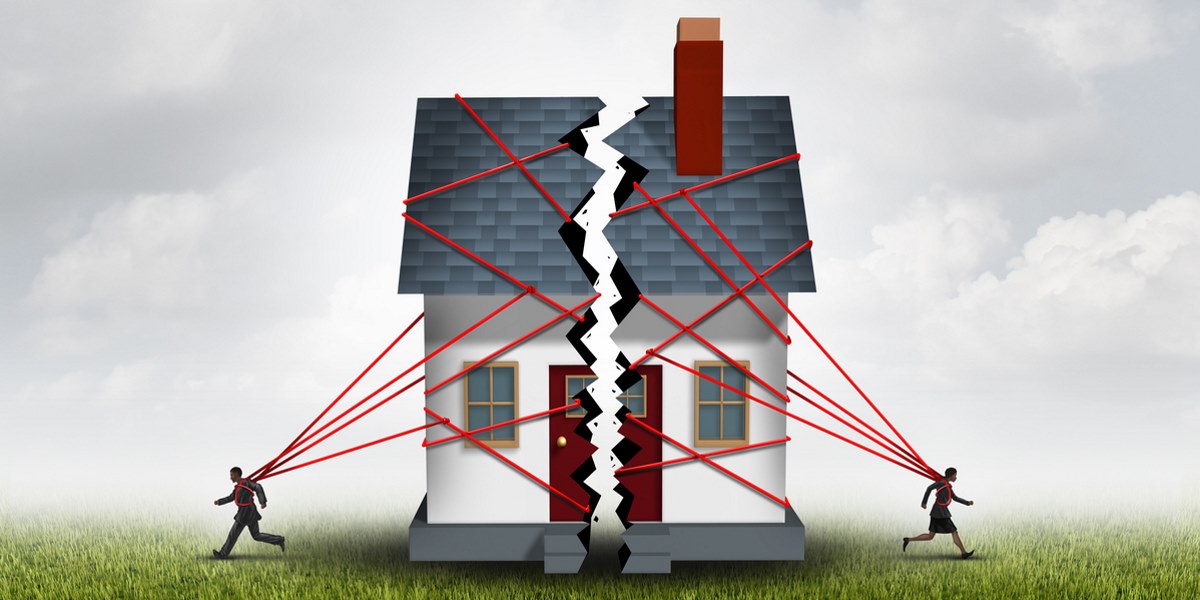Divorce statistics for England and Wales: small rise in couples divorcing amid general decline
Last updated on May 20th, 2021 at 08:48 pm

Recent figures showing a year-on-year rise in the number of divorces in England and Wales between 2015 and 2016 actually obscure a wider narrative about divorce in this country; namely, that the increasing divorce trend seen since the 1960s seems to have been in decline over the last decade.
Office for National Statistics (ONS) data shows there was a 5.8% rise in divorces between opposite-sex couples in 2016 (the most current year for which we have data) compared with 2015.
This works out at a total of 106,959 divorces in 2016. In fact, estimates suggest that 42% of marriages will ultimately end in divorce. This is a rise from the 22% seen in the 1970.

Yet we are starting to see a slight shift from this trajectory. While it is difficult to produce the current figures on the proportion of marriages ending in divorce, due to the fact that marriages are ongoing, when we look at relationships in terms of specific anniversaries, we see that a higher percentage are now lasting at least until these landmark dates have been reached.
Percentage of marriages which have ended in divorce, by year of marriage in England and Wales (2011)
|
Year of marriage |
By anniversary (years) |
||||||||||
|
0
|
1
|
2
|
3
|
4
|
5
|
6
|
7
|
8
|
9
|
10
|
|
| 1970 | 0.0 | 0.0 | 0.1 | 0.2 | 2.1 | 4.5 | 6.8 | 8.9 | 10.9 | 12.8 | 14.6 |
| 1975 | 0.0 | 0.0 | 0.2 | 0.4 | 3.6 | 7.0 | 9.8 | 12.2 | 14.5 | 16.4 | 18.1 |
| 1980 | 0.0 | 0.0 | 0.2 | 0.5 | 4.7 | 8.5 | 11.5 | 14.1 | 16.5 | 18.7 | 20.7 |
| 1985 | 0.0 | 0.0 | 1.6 | 4.3 | 7.3 | 10.2 | 13.0 | 15.7 | 18.3 | 20.7 | 22.8 |
| 1990 | 0.0 | 0.0 | 1.5 | 4.3 | 7.6 | 10.9 | 14.0 | 16.8 | 19.3 | 21.5 | 23.6 |
| 1995 | 0.0 | 0.0 | 1.6 | 4.5 | 7.7 | 10.8 | 13.9 | 16.8 | 19.7 | 22.4 | 24.7 |
| 2000 | 0.0 | 0.0 | 1.3 | 4.0 | 7.2 | 10.4 | 13.3 | 16.1 | 18.5 | 20.7 | 22.8 |
| 2005 | 0.0 | 0.0 | 1.1 | 3.1 | 5.5 | 8.3 | 11.1 | ||||
In fact, if we look to the table below on divorce rates (number of divorces per 1,000 married men and women for a given year) in England and Wales we will notice a steady increase from 1950 through to the mid-1980s, when the rate held reasonably steady for almost 20 years, reaching its highest peak in 1994.
But by 2005, the figure begins to fall, standing at 9.8 divorces per 1,000 married men and women in 2013, a 31% drop from the 14.2 figure seen in 1994.
Divorce Rates (persons divorcing per 1,000 married male/female population aged 16 and over*)
| 1950 | 2.8 | 1959 | 2.1 | 1968 | 3.7 | 1977 | 10.4 | 1986 | 12.9 | 1995 | 13.7 | 2004 | 13.3 | 2013 | 9.8 |
| 1951 | 2.6 | 1960 | 2 | 1969 | 4.1 | 1978 | 11.6 | 1987 | 12.7 | 1996 | 13.6 | 2005 | 12.2 | ||
| 1952 | 3 | 1961 | 2.1 | 1970 | 4.7 | 1979 | 11.2 | 1988 | 12.8 | 1997 | 13 | 2006 | 11.5 | ||
| 1953 | 2.7 | 1962 | 2.4 | 1971 | 5.9 | 1980 | 12 | 1989 | 12.7 | 1998 | 12.9 | 2007 | 11.1 | ||
| 1954 | 2.5 | 1963 | 2.7 | 1972 | 9.5 | 1981 | 11.9 | 1990 | 13 | 1999 | 12.9 | 2008 | 10.5 | ||
| 1955 | 2.4 | 1964 | 2.9 | 1973 | 8.4 | 1982 | 12.1 | 1991 | 13.5 | 2000 | 12.7 | 2009 | 9.8 | ||
| 1956 | 2.3 | 1965 | 3.1 | 1974 | 9 | 1983 | 12.2 | 1992 | 13.9 | 2001 | 12.9 | 2010 | 10.2 | ||
| 1957 | 2.1 | 1966 | 3.2 | 1975 | 9.6 | 1984 | 12 | 1993 | 13.8 | 2002 | 12.8 | 2011 | 10.1 | ||
| 1958 | 1.9 | 1967 | 3.5 | 1976 | 10.1 | 1985 | 13.4 | 1994 | 14.2 | 2003 | 13.3 | 2012 | 10 |
* latest data available, released 2016
Head of family solicitors at Graysons, Bradie Pell, said: “It is likely that the trend in divorce represents the social trends of the time. In the 1950s the social culture began to shift and divorce was not so much of a “taboo”. This again continued in the 1980s and 1990s. It is interesting that the percentage then falls — this could reflect a decrease in the amount of couples choosing to marry.”
Why are divorce rates falling?
The total number of divorces in England and Wales has actually been dropping for the past 30 years (see below); however, this figure is a misleading one.
ONS data on the number of marriages since the 1960s shows that the figure has also dropped. It is logical to presume that fewer marriages will naturally result in fewer divorces.
But why has marriage declined and does this have anything to tell us about the drop in divorce that has seemingly occurred?
A fundamental shift in the way divorce is perceived both by the law and within wider society is thought to have had a direct impact on divorce rates in the UK.

Over the last 50 years, changes in attitudes and behaviours have impacted on marriage statistics, both in terms of numbers and the age at which people first wed. This, in turn, has affected divorce rates in the UK.
- Over the decades it has become increasingly acceptable to live together without being married. Most people (60%) nowadays have a period of cohabitation before they become married.
- Role of women. Women’s lives began to change in the first half of the 20th century following important gains won by the suffragette movement and later the impact of the Second World War. However, it was the latter half of the century when the careers and prospects of women in the UK dramatically altered, with more women now choosing to concentrate on further education and building careers for themselves.
- Age when first married. People are increasingly leaving it longer to get married. Data suggests that those who marry at a later age tend to divorce less.
- Changing expectations around marriage. Rising expectations about how a marriage ‘should be’ has led to an increase in relationship breakdowns, with many spouses no longer willing to stay in an unhappy relationship.
- People’s acceptance of divorce and the introduction of fixed fees has made divorce more accessible and affordable.
Age when divorced

The recent ONS figures show the age that people get divorced continues to increase. Over the last 2 decades the average age has risen 8 years for both men and women.
If we look at the most common age at which men and women divorce, we see that for men the figure is between 45 and 49, while for women it is 30 to 39.
The age difference is most likely down to the fact that women tend to marry at a younger age, and to men older than themselves.
Those who stick it out stay together
Interestingly, figures suggest that if you can make it past the first 10 years of marriage, your chances of getting divorced decreases.
Looking at the graph above, we see that at the beginning of the curve, the percentage of marriages ending in divorce increases as the length of relationship increases — as one would expect. However, by the 10-year mark, the increase in divorces among all married people starts to slow, indicating that fewer people decide to divorce when they have been married for a length of time.
By the time married couples reach their 20th wedding anniversary, the increase sees a rapid slowdown.
But it’s not just length of marriage that can affect the probability of divorce; research also shows that people who have divorced once before are more likely to do so again.
Reasons for divorce
Since 1974 when the current rules on divorce came into effect, to get divorced in England and Wales couples have had to prove that the marriage has irretrievably broken down. To establish this, you must note on the divorce petition one of the following five reasons:
- adultery
- unreasonable behaviour
- desertion
- 2 years separation with consent
- 5 years separation (no consent required)
The most recent data shows the most common reason for divorce to be ‘unreasonable behaviour’. This has been the most common reason given by women since 1974. However, the most common reason for men has changed over the years, with ‘adultery’ cited more often across the 1980s, and ‘separation’ given in the first half-decade of the new millennium.
| Year of divorce | Party to whom granted | Adultery, % | Behaviour, % | Desertion, % | Separation (2 years and consent), % | Separation (5 years), % | Year of divorce | Party to whom granted | Adultery, % | Behaviour, % | Desertion, % | Separation (2 years and consent), % | Separation (5 years), % | |
| 1974 | Wife | 25 | 33 | 6 | 23 | 11 | 1994 | Wife | 22 | 54 | 1 | 19 | 5 | |
| 1974 | Husband | 39 | 6 | 5 | 28 | 21 | 1994 | Husband | 37 | 24 | 1 | 28 | 10 | |
| 1975 | Wife | 25 | 35 | 5 | 24 | 9 | 1995 | Wife | 22 | 52 | 1 | 20 | 5 | |
| 1975 | Husband | 41 | 6 | 4 | 31 | 18 | 1995 | Husband | 36 | 24 | 1 | 29 | 10 | |
| 1976 | Wife | 24 | 38 | 5 | 23 | 8 | 1996 | Wife | 22 | 53 | 1 | 20 | 5 | |
| 1976 | Husband | 40 | 7 | 3 | 32 | 17 | 1996 | Husband | 34 | 24 | 1 | 30 | 11 | |
| 1977 | Wife | 24 | 39 | 4 | 23 | 8 | 1997 | Wife | 22 | 53 | 1 | 19 | 5 | |
| 1977 | Husband | 40 | 8 | 3 | 32 | 17 | 1997 | Husband | 34 | 26 | 1 | 30 | 10 | |
| 1978 | Wife | 23 | 41 | 4 | 24 | 8 | 1998 | Wife | 22 | 53 | 0 | 19 | 5 | |
| 1978 | Husband | 40 | 9 | 3 | 32 | 15 | 1998 | Husband | 32 | 27 | 1 | 30 | 10 | |
| 1979 | Wife | 24 | 41 | 3 | 24 | 7 | 1999 | Wife | 22 | 53 | 0 | 20 | 5 | |
| 1979 | Husband | 41 | 9 | 3 | 33 | 14 | 1999 | Husband | 30 | 27 | 1 | 31 | 11 | |
| 1980 | Wife | 25 | 42 | 3 | 23 | 6 | 2000 | Wife | 22 | 52 | 0 | 20 | 6 | |
| 1980 | Husband | 42 | 10 | 2 | 32 | 13 | 2000 | Husband | 29 | 28 | 1 | 31 | 12 | |
| 1981 | Wife | 25 | 44 | 2 | 23 | 6 | 2001 | Wife | 21 | 53 | 0 | 20 | 6 | |
| 1981 | Husband | 43 | 10 | 2 | 32 | 12 | 2001 | Husband | 27 | 29 | 1 | 31 | 12 | |
| 1982 | Wife | 24 | 46 | 2 | 22 | 5 | 2002 | Wife | 20 | 52 | 0 | 21 | 6 | |
| 1982 | Husband | 44 | 12 | 2 | 31 | 12 | 2002 | Husband | 27 | 29 | 1 | 31 | 12 | |
| 1983 | Wife | 24 | 47 | 2 | 22 | 5 | 2003 | Wife | 20 | 52 | 0 | 21 | 7 | |
| 1983 | Husband | 44 | 13 | 2 | 30 | 12 | 2003 | Husband | 26 | 30 | 1 | 31 | 13 | |
| 1984 | Wife | 25 | 46 | 1 | 22 | 5 | 2004 | Wife | 19 | 52 | 0 | 21 | 7 | |
| 1984 | Husband | 43 | 14 | 1 | 30 | 12 | 2004 | Husband | 25 | 30 | 0 | 32 | 13 | |
| 1985 | Wife | 24 | 50 | 1 | 20 | 4 | 2005 | Wife | 19 | 53 | 0 | 21 | 7 | |
| 1985 | Husband | 44 | 16 | 1 | 28 | 10 | 2005 | Husband | 23 | 31 | 1 | 32 | 14 | |
| 1986 | Wife | 25 | 51 | 1 | 19 | 4 | 2006 | Wife | 18 | 54 | 0 | 20 | 7 | |
| 1986 | Husband | 44 | 17 | 1 | 27 | 11 | 2006 | Husband | 21 | 32 | 1 | 32 | 14 | |
| 1987 | Wife | 25 | 52 | 1 | 18 | 4 | 2007 | Wife | 17 | 54 | 0 | 21 | 8 | |
| 1987 | Husband | 45 | 18 | 1 | 25 | 10 | 2007 | Husband | 20 | 33 | 0 | 33 | 14 | |
| 1988 | Wife | 25 | 53 | 1 | 17 | 5 | 2008 | Wife | 17 | 54 | 0 | 21 | 8 | |
| 1988 | Husband | 44 | 20 | 1 | 25 | 10 | 2008 | Husband | 18 | 34 | 1 | 32 | 14 | |
| 1989 | Wife | 24 | 54 | 1 | 17 | 4 | 2009 | Wife | 16 | 54 | 0 | 22 | 8 | |
| 1989 | Husband | 43 | 21 | 1 | 25 | 10 | 2009 | Husband | 17 | 35 | 1 | 33 | 14 | |
| 1990 | Wife | 24 | 55 | 1 | 16 | 4 | 2010 | Wife | 15 | 55 | 0 | 21 | 8 | |
| 1990 | Husband | 42 | 22 | 1 | 25 | 10 | 2010 | Husband | 16 | 36 | 1 | 32 | 15 | |
| 1991 | Wife | 23 | 56 | 1 | 16 | 4 | 2011 | Wife | 15 | 54 | 0 | 22 | 9 | |
| 1991 | Husband | 42 | 23 | 1 | 25 | 10 | 2011 | Husband | 15 | 36 | 1 | 32 | 16 | |
| 1992 | Wife | 23 | 55 | 1 | 17 | 4 | 2012 | Wife | 14 | 54 | 1 | 22 | 9 | |
| 1992 | Husband | 41 | 23 | 1 | 26 | 10 | 2012 | Husband | 14 | 37 | 1 | 32 | 17 | |
| 1993 | Wife | 23 | 54 | 1 | 18 | 4 | ||||||||
| 1993 | Husband | 39 | 23 | 1 | 28 | 10 |
Bradie Pell said: “The trend in divorce has changed over the decades; principally due to the change is social culture. It will be interesting to see if the Government does eventually adopt a “none fault divorce” and how this will affect the statistics — will it encourage people to divorce or, will the stats stabilise.”
